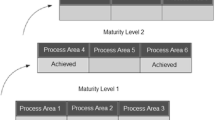Abstract
A system documentation process maturity model and assessment procedure were developed and used to assess 78 projects at 28 different companies over a five year period. During this time the original version evolved into second and third versions based on feedback from industry and the experience gained from the assessments. The changes to the model, maturity levels, key practices, scoring scheme and assessment report, and the reasons behind these changes are analyzed in this paper. The biggest lesson learned is that the key practices' degree of satisfaction and not the maturity levels drive the assessment and provide the key information needed for process improvement.
Similar content being viewed by others
References
I. Burnstein, T. Suwannasart and C. Carlson. Developing a testing maturity model: Part I. CrossTalk, 9(6), (1996), 21–24.
D. Card, F. McGarry and G. Page. Evaluating software engineering technologies. IEEE Trans. Software Eng., 13(7), (1987), 845–851.
C. Cook and M. Visconti. New and improved documentation process model. Proceedings of the 14th Pacific Northwest Software Quality Conference, Portland, Oregon, 1996, pp. 364–380.
K. El Emam, J.N. Drouin and W. Melo. SPICE: The Theory and Practice of Software Improvement and Capability Determination. (IEEE Computer Society, 1998).
N. Fenton and S. Pfleeger. Software Metrics: A Rigorous & Practical Approach, 2nd ed. (PWS, London 1997).
W. Humphrey. Managing the Software Process. (Addison-Wesley, Reading, 1989).
B. Lientz and E. Swanson. Problems in applications software maintenance. Comm. ACM, 24(11), (1981), 763–769.
M. Paulk, B. Curtis, M. Chrissis and C. Weber. The Capability Maturity Model Guidelines for Improving the Software Process. (Addison-Wesley, Reading, 1995).
M. Paulk, B. Curtis, M. Chrissis and C. Weber. Capability maturity model, version 1.1. IEEE Software, 10(4), (1993), 18–27.
J. Pence and S. Hon. Building software quality into telecommunications network systems. Quality Progress, (October), (1993), 95–97.
L. Poulin. S:PRIME. Proceedings of VISION Conference (CRIM-ASEC), Montreal, Canada, 1996.
H. Rombach and V. Basili. Quantitative assessment of maintenance: an industrial case study. Proceedings of the IEEE Conference on Software Maintenance, Austin, Texas, 1987, pp. 134–144.
F. van Latum, R. van Solingen, M. Oivo, B. Hoisl, D. Rombach and G. Ruhe. Adopting GQM-based measurement in an industrial environment. IEEE Software, 15(1), (1998), 78–86.
M. Visconti and C. Cook. A software system documentation process maturity approach to software quality, Proceedings 11th Pacific Northwest Software Quality Conference, Portland, Oregon, 1993, pp. 257–271.
M. Visconti, P. Antiman and P. Rojas. Experiencia con un modelo de madurez para el mejoramiento del proceso de aseguramiento de calidad del software. Novatica, 125, (1997), 18–21. (In Spanish)
Author information
Authors and Affiliations
Rights and permissions
About this article
Cite this article
Visconti, M., Cook, C.R. Evolution of a maturity model – critical evaluation and lessons learned. Software Quality Journal 7, 223–237 (1998). https://doi.org/10.1023/A:1008979221881
Issue Date:
DOI: https://doi.org/10.1023/A:1008979221881




